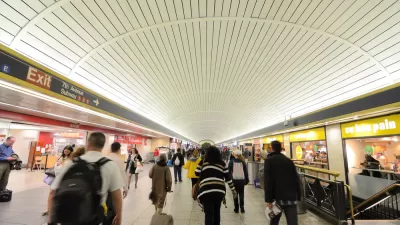Similar to high-speed rail projects throughout the nation, Amtrak will be looking to the private sector to help pay a portion of the expected $20 billion tab to build two new tunnels under the Hudson River and expand New York's Penn Station.
The project "certainly seems to lend itself to some aspect of public-private partnership involvement, particularly in station development," said Drew Galloway, Amtrak's deputy chief of Northeast Corridor Planning and Performance, about the plan known as Gateway Program, write Hilary Russ and Edward Krudy for Reuters.
Private financing would be especially suited to the expansion and revamp of New York's Penn Station, but could also help fund tunnel construction itself, said Galloway
The Gateway Development Corporation, which will be housed within the Port Authority of New York and New Jersey, will be in charge of the project. Amtrak and the U.S. Department of Transportation will pay half the cost, and New York and New Jersey will pay the other half.
The Port Authority is already using public-private partnerships for a $4 billion LaGuardia Airport upgrade and a $1.5 billion revamp of (the Goethals Bridge) linking Staten Island to New Jersey.
According to the Reuters' graphic, the Gateway Program would be the third "largest in the United States using a combination of private and public money" after California high-speed rail and California's Bay Delta Conservation Plan.
Private funding is possible when there is a revenue component to the project, such as toll roads and bridges. "A surcharge on commuter tickets, tolls for freight traffic or facility maintenance payments are possible ways for private sector players to earn back their investments, analysts said," add Russ and Krudy
In other rail projects, private funds are expected to foot most, if not all of the cost of the:
- DesertXpress high-speed rail from Victorville, Calf. to Las Vegas
- Texas Central Railway (high-speed rail from Dallas to Houston)
- All Aboard Florida (125 mph rail from Miami to Orlando)
- Northeast Maglev from Washington to Baltimore
FULL STORY: Tight budgets open $20 billion New York tunnel plan to private cash

Study: Maui’s Plan to Convert Vacation Rentals to Long-Term Housing Could Cause Nearly $1 Billion Economic Loss
The plan would reduce visitor accommodation by 25,% resulting in 1,900 jobs lost.

Alabama: Trump Terminates Settlements for Black Communities Harmed By Raw Sewage
Trump deemed the landmark civil rights agreement “illegal DEI and environmental justice policy.”

Why Should We Subsidize Public Transportation?
Many public transit agencies face financial stress due to rising costs, declining fare revenue, and declining subsidies. Transit advocates must provide a strong business case for increasing public transit funding.

Paris Bike Boom Leads to Steep Drop in Air Pollution
The French city’s air quality has improved dramatically in the past 20 years, coinciding with a growth in cycling.

Why Housing Costs More to Build in California Than in Texas
Hard costs like labor and materials combined with ‘soft’ costs such as permitting make building in the San Francisco Bay Area almost three times as costly as in Texas cities.

San Diego County Sees a Rise in Urban Coyotes
San Diego County experiences a rise in urban coyotes, as sightings become prevalent throughout its urban neighbourhoods and surrounding areas.
Urban Design for Planners 1: Software Tools
This six-course series explores essential urban design concepts using open source software and equips planners with the tools they need to participate fully in the urban design process.
Planning for Universal Design
Learn the tools for implementing Universal Design in planning regulations.
Smith Gee Studio
Alamo Area Metropolitan Planning Organization
City of Santa Clarita
Institute for Housing and Urban Development Studies (IHS)
City of Grandview
Harvard GSD Executive Education
Toledo-Lucas County Plan Commissions
Salt Lake City
NYU Wagner Graduate School of Public Service



























